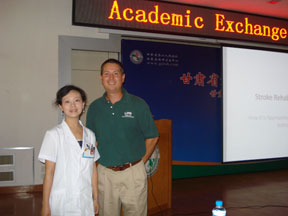UAB alumni Tom and Janet Hicks began working in China as physicians in 1996. They have seen steady progress in the quality of care provided during the past 15 years, but there is much more that needs to be done — especially in physical therapy.
 |
| Scott Bickel (right), assistant professor of physical therapy, was among a team of eight people — six with UAB ties — that spent a week in Lanzhou, China, teaching physical therapy techniques to health-care providers. |
So the Hickses invited a team of physicians, nurses and other health-care providers to China. As a result, an interdisciplinary team of eight people — six with UAB ties — spent a week in Lanzhou, China, this past summer. Part of their mission was to teach physical therapy techniques to health-care providers at a hospital and nursing home. They also lectured on the state of practice in trauma/burns ICU, pediatric critical care and laparoscopic surgery.
“The Chinese government realizes its rehab programs are not doing as well as they could,” says Scott Bickel, Ph.D., assistant professor in the Department of Physical Therapy and one of the team members. “In some aspects, it’s like going back in time 40 years. People stay in the hospital longer than they do here. Their rehab options are very limited. They see they can be doing better in that area, and they want to improve.”
Bickel and his fellow team members spoke and conducted training sessions at a Lanzhou hospital and a local nursing home. Other UAB team members on the trip were Brittni Russell, registered nurse in Trauma/Burn ICU and a School of Nursing alumni; Kate Sewell, registered nurse at Children’s Hospital and a School of Nursing alumni; Jenny Wilson, physical therapist at Spain Rehabilitation Center and Department of Physical Therapy alumni; Lee Willingham, a student in pre-nursing; and Gabrielle Hood a student in pre-med. Other team members included David Mallette, a physical therapist and clinical instructor for UAB students; surgeon John Touliatos; and physician Tom Worthington.
The UAB team also trained community health workers and nursing home volunteers on best-practice physical therapy techniques that ranged from turning patients in their beds to basic exercises patients can do for a variety of problems.
China is the world’s most populous nation, with more than 1.3 billion people. Bickel says the best estimate is that 30,000 of those 1.3 billion could be considered a rehab professional — that could be a physician, therapist, occupational therapist or anyone who calls himself a rehab professional.
By comparison, the United States has a population of 300 million and 200,000 physical therapy jobs.
“And that doesn’t count physicians or occupational therapists,” Bickel says. “China has a big discrepancy in terms of the population to rehab professionals. But they want to improve that and increase the number of people and quality of training.”
Hicks says the quality of physical therapy care provided in China often varies by region. There are some areas in the east that have strong programs, he says, but the northwest, where he and Janet work, is struggling.
Hicks hoped that bringing professionals from the United States to demonstrate physical therapies to local hospital staff would encourage them to think about ways to develop their program.
“I think the visit was very successful,” Hicks says. “They opened some eyes and caused some people who already thought they were doing physical therapy — when it really was just a massage — to reevaluate what they were doing in terms of patient care and outcomes. I have high hopes this will stimulate further development of PT in local hospitals.”
Bickel had traveled to Beijing previously and seen patient rehabilitation in some of the largest hospitals. This summer’s trip provided him an opportunity to compare the big hospital experience with the treatment in rural settings.
“In Beijing there are rehab professionals and a rehab department in the hospital,” Bickel says. “Now you go out to this rural hospital in Lanzhou, and there’s a rehab department, but with much fewer personnel. But at the nursing home there is none. So there is a great need.”
The Department of Physical Therapy has been part of multiple projects in China in recent years through Project Hope, connected to UAB through Howard Houser, Ph.D., professor emeritus and the former associate dean in the School of Health Professions. Houser and UAB personnel have made trips to China and hosted visiting scholars to train in rehabilitation.
Both Bickel and Hicks hope there can be future partnerships.
“For the past seven years, I’ve been trying to find ways to tie my profession to some international activities, and I have an interest in that part of the world,” Bickel says. “My mother was born in China, and we adopted a child from Taiwan. There’s a great need there, and I hope to continue to be part of helping out.”
